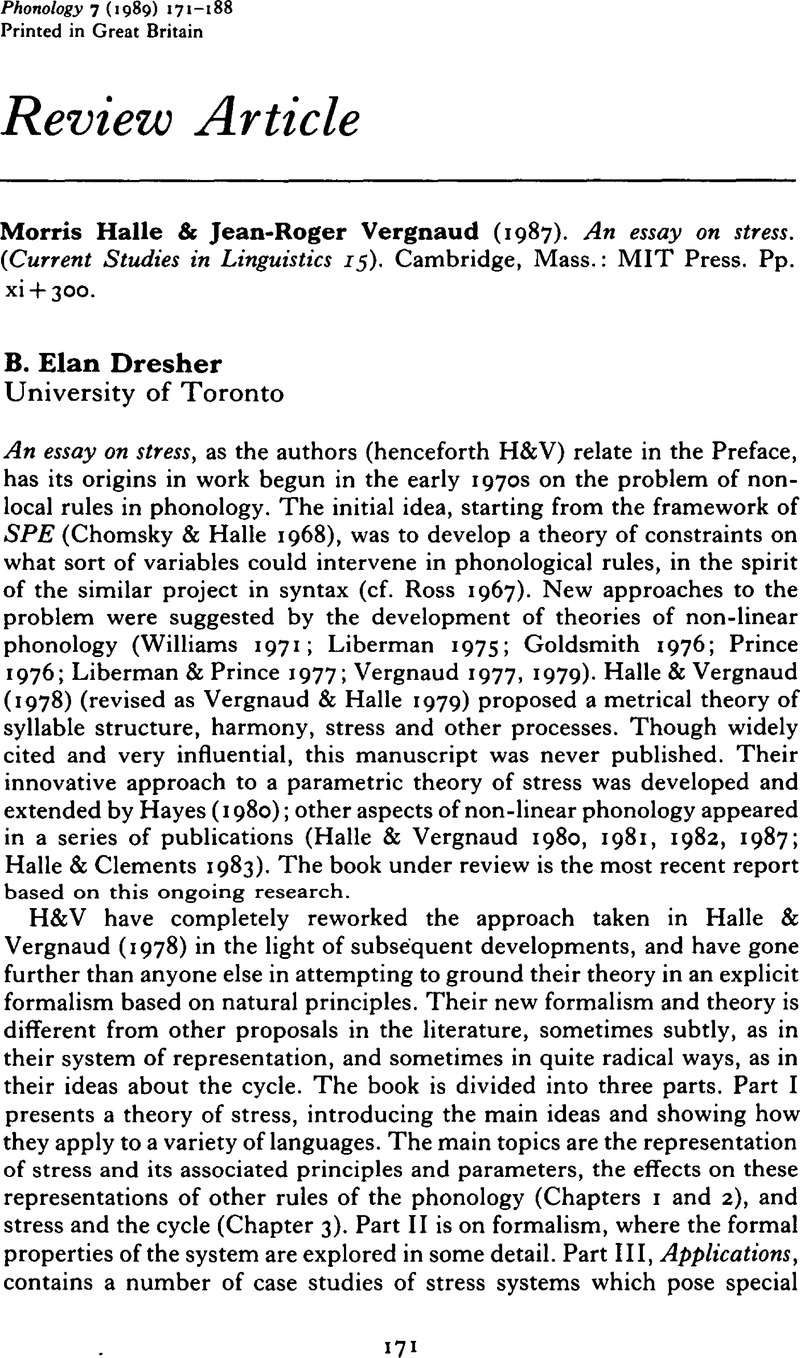No CrossRef data available.
Article contents
Morris Halle & Jean-Roger Vergnaud (1987). An essay on stress. (Current Studies in Linguistics 15). (Cambridge, Mass.: MIT Press. Pp. xi + 300
Review products
Morris Halle & Jean-Roger Vergnaud (1987). An essay on stress. (Current Studies in Linguistics 15). (Cambridge, Mass.: MIT Press. Pp. xi + 300
Published online by Cambridge University Press: 20 October 2008
Abstract
An abstract is not available for this content so a preview has been provided. Please use the Get access link above for information on how to access this content.

- Type
- Review
- Information
- Copyright
- Copyright © Cambridge University Press 1990
References
REFERENCES
Archangeli, D. (1984). Underspecification in Yawelmani phonology and morphology. PhD dissertation, MIT.Google Scholar
Archangeli, D. (1986). Extrametricality and the Percolation Convention. Ms, University of Arizona.Google Scholar
Chung, S. (1983). Transderivational relationships in Chamorro phonology. Lg 59. 35–66.Google Scholar
Dresher, B. E. & J., Kaye (1990). A computational learning model for metrical phonology. Cognition 34. 137–195.Google Scholar
Dresher, B. E. & Lahiri, A. (1989). The Germanic foot: metrical coherence in Old English. Ms, University of Toronto and Max Planck Institut für Psycholinguistik, Nijmegen.Google Scholar
Giegerich, H. J. (1985). Metrical phonology and phonological structure: German and English. Cambridge: Cambridge University Press.Google Scholar
Goldsmith, J. (1976). Autosegmental phonology. PhD dissertation, MIT. Published 1979, New York: Garland.Google Scholar
Halle, M. (to appear). Respecting metrical structure. NLLT.Google Scholar
Halle, M. & Clements, G. N. (1983). Problem book in phonology. Cambridge, Mass.: MIT Press.Google Scholar
Halle, M. & Mohanan, K. P. (1985). Segmental phonology of Modern English. LI 16. 57–116.Google Scholar
Halle, M. & Vergnaud, J.-R. (1978). Metrical structures in phonology. Ms, MIT. Revised as Vergnaud & Halle (1979).Google Scholar
Halle, M. & Vergnaud, J.-R. (1980). Three-dimensional phonology. Journal of Linguistic Research I. 83–105.Google Scholar
Halle, M. & Vergnaud, J.-R. (1981). Harmony processes. In Klein, W. & Levelt, W. (eds.) Crossing the boundaries in linguistics. Dordrecht: Reidel. 1–23.Google Scholar
Halle, M. & Vergnaud, J.-R. (1982). On the framework of autosegmental phonology. In van der Hulst & Smith (1982b). 65–82.Google Scholar
Hammond, M. (1984). Constraining metrical theory: a modular theory of rhythm and destressing. PhD dissertion, UCLA. Distributed by Indiana University Linguistics Club. Published 1988, New York: Garland.Google Scholar
Hammond, M. (1986). The obligatory-branching parameter in metrical theory. NLLT 4. 185–228.Google Scholar
Harris, J. W. (1983). Syllable structure and stress in Spanish: a non-linear analysis. Cambridge, Mass.: MIT Press.Google Scholar
Harris, J. W. (1989). The stress erasure convention and cliticization in Spanish. LI 20. 339–363.Google Scholar
Hayes, B. (1980). A metrical theory of stress rules. PhD dissertation, MIT. Distributed 1981, Indiana University Linguistics Club.Google Scholar
Hogg, R. & McCully, C. B. (1987). Metrical phonology: a coursebook. Cambridge: Cambridge University Press.Google Scholar
Hulst, H.van, der & Smith, N. (1982a). An overview of autosegmental and metrical phonology. In van der Hulst & Smith (1982b). 1–45.Google Scholar
Hulst, H.van, der & Smith, N. (1982b). The structure of phonological representations. Part I. Dordrecht: Foris.Google Scholar
Hulst, H. van der & Smith, N. (1985). The framework of non-linear generative phonology. In van der Hulst, H. & Smith, N. (eds.) Advances in non-linear phonology. Dordrecht: Foris. 3–55.Google Scholar
Kaisse, E. (1985). Some theoretical consequences of stress rules in Turkish. CLS 21. 199–209.Google Scholar
Kaisse, E. M. & Shaw, P. A. (1985). On the theory of Lexical Phonology. Phonology Yearbook 2. 1–30.Google Scholar
Kiparsky, P. (1973). Phonological representations. In Fujimura, O. (ed.) Three dimensions of linguistic theory. Tokyo: TEC. 3–136.Google Scholar
Kiparsky, P. (1982a). From cyclic phonology to lexical phonology. In van der Hulst & Smith (1982b). 131–175.Google Scholar
Kiparsky, P. (1985). Some consequences of Lexical Phonology. Phonology Yearbook 2. 85–138.Google Scholar
Leben, W. (1982). Metrical or autosegmental. In van der Hulst & Smith (1982b). 177–190.Google Scholar
Leer, J. (1985), Prosody in Alutiiq. In Krauss, M. (ed.) Yupik Eskimo prosodic systems: descriptive and comparative studies. Fairbanks: University of Alaska. 77–133.Google Scholar
Levin, J. (1985). Evidence for ternary feet and implications for a metrical theory of stress. Ms, University of Texas, Austin.Google Scholar
Lightfoot, D. (1989). The child's trigger experience: degree-o learnability. Behavioral and Brain Sciences 12. 321–375.Google Scholar
Mascaró, J. (1976). Catalan phonology and the phonological cycle. PhD dissertation, MIT.Google Scholar
Paradis, C. (1988). On constraints and repair strategies. The Linguistic Review 6. 71–97.Google Scholar
Rice, C. (1988). Stress assignment in the Chugach dialect of Alutiiq. Ms, University of Texas, Austin.Google Scholar
Rice, K. (1986). The function of structure preservation: derived environments. NELS 17. 501–519.Google Scholar
Selkirk, E. O. (1984). Phonology and syntax: the relation between sound and structure. Cambridge, Mass.: MIT Press.Google Scholar
Shaw, P. A. (1985). Modularisation and substantive constraints in Dakota lexical phonology. Phonology Yearbook 2. 173–202.Google Scholar
Vergnaud, J.-R (1977). Formal properties of phonological rules. In Butts, R. & Hintikka, J. (eds.) Basic problems in methodology and linguistics. Dordrecht: Reidel. 299–318.Google Scholar
Vergnaud, J.-R. (1979) A formal theory of vowel harmony. In Vago, R. (ed.) Issues in vowel harmony. Amsterdam: John Benjamins. 49–63.Google Scholar
Vergnaud, J.-R. & Halle, M. (1979). Metrical phonology: a fragment of a draft. Ms, MIT.Google Scholar
Williams, E. (1971). Underlying tone in Margi and Igbo. Published 1976, LI 7. 463–484.Google Scholar


